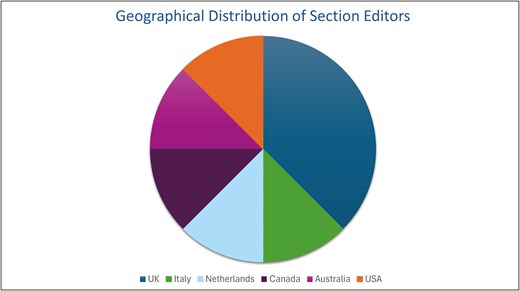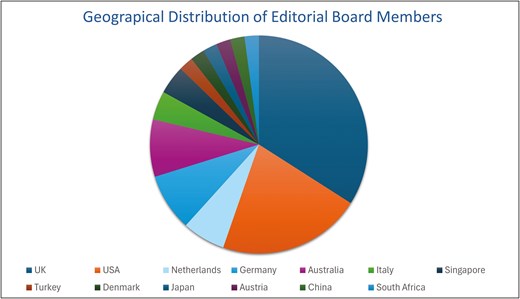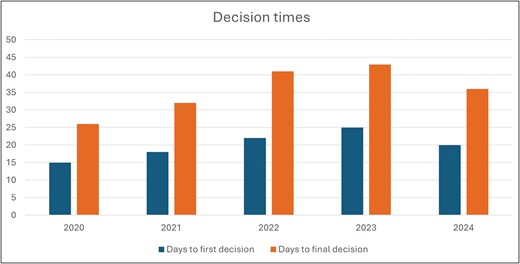-
PDF
- Split View
-
Views
-
Cite
Cite
Leonie S Taams, My highlights as Editor-in-Chief of Clinical & Experimental Immunology, 2017–2024, Clinical and Experimental Immunology, Volume 219, Issue 1, 2025, uxae112, https://doi.org/10.1093/cei/uxae112
Close - Share Icon Share
In January 2017, I started as Editor-in-Chief of Clinical & Experimental Immunology (CEI). Now, 8 years later, and in my final editorial for the journal, I would like to take a moment to reflect on this period and highlight some of the amazing changes and developments that have happened during this time.
When I started in 2017, the journal had three Associate Editors, all of whom were men: Professor Xiao-Ning Xu, Dr Danny Douek, and Professor Angelo Manfredi. As of 2024, CEI has seven Section Editors (four men, and three women) who manage six different sections: Neuroimmunology (led by Professor Sandra Amor), Cancer Immunology (led by Professor Tanja de Gruijl), Infectious Diseases and Vaccines (jointly led by Dr Danny Douek and Professor Xiao-Ning Xu), Autoimmunity (led by Professor Angelo Manfredi), Immune-Mediated Inflammatory Diseases (led by Professor Ciriaco Piccirillo), and Immunodeficiency (led by Professor Cindy Ma). The geographical spread of our Section Editors covers immunology globally, from Canada, USA, UK, Netherlands, and Italy to Australia (Fig. 1). Since 2020, each Section has had its own dedicated editorial board, with further representation of multiple geographical regions from 15 different countries (Fig. 2) and a more representative gender balance (26 men and 19 women). An additional key development in recent years to support the development of the next generation of immunologists was the introduction of an Early Career Researcher Editorial Board in 2021, consisting of 12 energetic international early career researchers (ECRs) who have contributed papers, reviewed submissions, and attended editorial board meetings.


During my time as Editor-in-Chief, the journal received more than 4500 submissions from 93 different countries and published more than 1150 papers. This is an incredible number, and I would like to thank all authors who have submitted their work for consideration by the journal, and all peer reviewers for their generous time and effort in reviewing the submissions—we deeply appreciate it. With the support and effort of our Section Editors, editorial board members, and our many voluntary peer reviewers, we managed to maintain an average time to first decision of 19 days and an average time to final decision of 35 days (Fig. 3).

The impact factor of the journal has remained strong and stable in a fast-changing publishing world. The impact can, of course, be measured in many ways, and we are proud to see that CEI papers received more than 250 000 Altmetric mentions and almost 18 000 citations during my time as Editor-in-Chief. Some of our most highly cited review papers of the past 8 years were ‘TIGIT as an emerging immune checkpoint’, ‘Production of complement components by cells of the immune system’, ‘The microbiome in autoimmune diseases’, ‘Ageing and inflammation in patients with HIV infection’, and ‘Vaccines for COVID-19’. With regards to primary research papers, the following publications attracted very high citation rates: ‘NLRP3 inflammasome activation contributes to the pathogenesis of rheumatoid arthritis’, ‘Using IL-2R/lymphocytes for predicting the clinical progression of patients with COVID-19’, ‘Protein arginine deiminase 4 inhibition is sufficient for the amelioration of collagen-induced arthritis’, ‘Type 2 diabetes is associated with the accumulation of senescent T cells’, and ‘Exosomes in HNSCC plasma as surrogate markers of tumour progression and immune competence’.
Simply by looking at the titles of these papers, one can immediately identify some of the key developments in the fields of cancer immunology, autoimmunity, inflammation, and infectious diseases during the past 8 years.
We also introduced our highly popular Review Series to the journal. These offer a way to highlight related topics as a collection, rather than publishing separate independent reviews. This collection is then published, together with a summarizing editorial article and additional promotional activities provided by the wonderful Communications Team at the British Society for Immunology (BSI). Many of these Series were led by guest editors, and we are very grateful for their time and effort in supporting the journal and the field of immunology. In total, we published 22 Review Series in the past 8 years, and I truly hope that this initiative will continue to thrive in the coming years. If you have a proposal for a Review Series, then please do contact our editorial team at [email protected].
We also developed a second Series called ‘The Clinical and Experimental Treatment of...’. In this Series, leading scientists succinctly summarize key current and anticipated therapeutic developments in a particular condition. This series was conceptualized by one of our editorial board members, Professor Dietmar Zaiss, and has thus far showcased four different conditions. If you would like to put the spotlight on a topic or condition of interest, then please contact our editorial team.
In addition to all these positive developments, new challenges and unknowns have entered the arena too. One of these is the exponential rise in the use and application of artificial intelligence and machine learning. Whilst these technologies offer amazing opportunities for research and data analysis, they undoubtedly present challenges with regard to source validation, analytical rigour, and data verification in scientific literature. These issues will need to be carefully considered and addressed by the scientific and publishing community alike.
The overall journal publishing landscape changed significantly as well with an increasing move towards open access publications. The BSI changed publisher from Wiley to Oxford University Press in 2021 and generated a broader portfolio of BSI journals through the creation of two new BSI Open Access journals: Immunotherapy Advances, led by Professor Tim Elliott, and Discovery Immunology, led by Professor Simon Milling. It has been wonderful to be part of the conceptualization of these journals and to work with Tim and Simon to help the journals develop, mature, and gain their place in the immunology Open Access publishing market. Critically, the collective income from the journals will continue to be invested into many BSI activities including our ever-popular Congress, awards, grants, and many other mechanisms via which the BSI supports our fantastic community.
I would like to use my final sentences to thank the wonderful team that helps make Clinical & Experimental Immunology an outstanding journal in translational and clinical immunology, and that made the Editor-in-Chief job so easy and pleasant to do: all our Section Editors, editorial board members, ECR board, all past and present BSI office members, Trustees and CEOs, and all our authors and peer reviewers. Thank you all for your support and dedication to the journal!
Please continue to offer your time, generosity, and, most importantly, your papers to Professor Claudia Mauri, who will take over from me as Editor-in-Chief. Claudia is a fantastic immunologist and a long-standing supporter of the BSI, and I am confident that she will continue to take the journal from strength to strength.
Thank you all!
Conflict of Interests
L.S.T. has been the Editor-in-Chief of Clinical & Experimental Immunology since 2017.
Data Availability
Not applicable for this Editorial.



